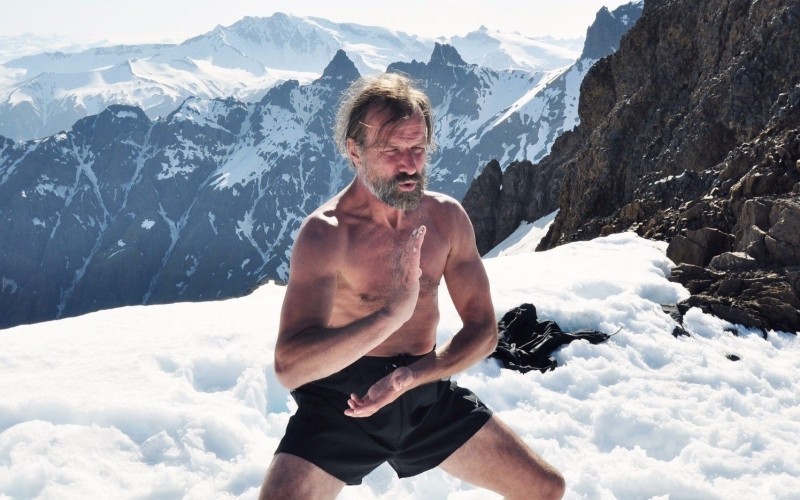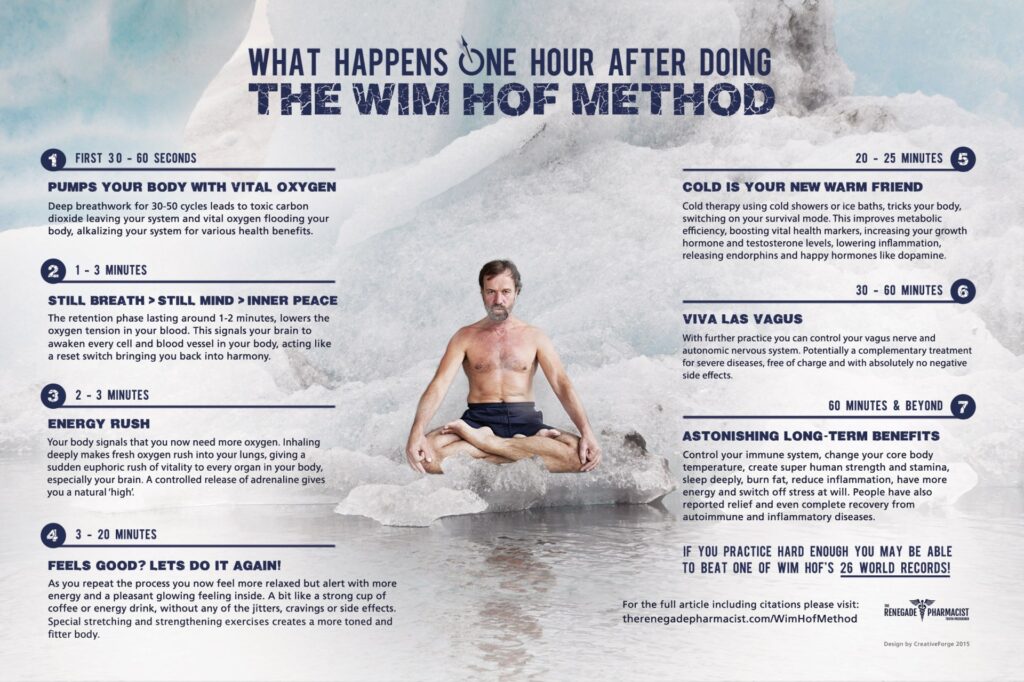Of all the unique and inspirational personalities in the fitness and wellness world, one of my favorites is definitely Wim Hof. If you’re unaware of the Wim Hof breathing methods, techniques, and benefits they can offer, you need to investigate The Ice Man a little more.
At first glance, most people are not quite sure what to make of Wim Hof. The Wim Hof breathing exercise program shows him sitting on a snowy mountain in nothing other than his swimming trunks.
The Wim Hof breathing YouTube videos where he’s huffing and puffing and talking excitedly about “charging the body.”
Or maybe it’s just his unique accent that causes people to hesitate. The Iceman from The Netherlands doesn’t sound like a medical doctor; should I trust him? It’s all very intriguing, but many of us simply assume it’s just an act or a hoax of some kind.
A Unique Path to Wim Hof Breathing
Wim Hof wasn’t always known as the Ice Man. He was born in Limburg, Netherlands, and was one of nine children. He was a man who was searching for answers and had the urge to jump into a frozen lake at the age of 17.
After 30 seconds in the water, he felt a connection with the cold water. It was there that Wim claims he knew the cold would be his teacher for years to come.
The way Wim Hof explains it, it was the cold water that changed how his breathing connected with his mind. Forcing himself to deal with the icy cold water changed his focus from his mind to his body.
Wim realized he had a deeper power he could tap into by using cold exposure.
Three Pillars of The Iceman
One of the three pillars of the Wim Hof Method is exposing your body to cold temperatures. An ice bath, cold shower, or stepping outside into the snow are all ways to introduce yourself to the cold.
Wim has tried them all. In March of 2000, he set the Guinness World Records for the furthest swim under a frozen lake. He set a world record for the fastest half-marathon on snow and ice, finishing in 2 hours, 16 minutes.
He’s also attempted climbing Mount Everest wearing only shorts and shoes. And has successfully climbed Mount Kilimanjaro while enduring the cold. The Dutch Ice Man has also set records for the longest ice bath. To say it another way, Wim likes the extreme cold.
He believes in the powerful effects of cold therapy, and creating an innerfire. Along with his incredible feats as an extreme athlete, Wim has brought awareness to the profound effect of cold exposure and breathing.
Breathing
By breathing, we can control our autonomic nervous system. You might be in disbelief, but this is one of the three pillars of the Wim Hof Method.
The amount of oxygen we breathe directly connects with the amount of energy released into our cells. Through physiological and chemical processes, one breathing session of deep breaths can have a huge impact on our body’s chemistry.

The WHM Breathing Technique
The basics of Wim Hof breathing or The Wim Hof Method, (WHM) consist of first getting comfortable in a sitting position or lying down. It’s also recommended to have an empty stomach before beginning. You also want only to do these exercises in a safe environment.
Next, take 30-40 deep breaths; some would call these power breaths. Inhale through the nose or mouth deeply at a steady pace, and exhale without using force.
Just let the air out. Any tingling or lightheadedness you might feel is completely normal at this point.
By wearing a pulse oximeter, you can watch the oxygen saturation fill your body as you take deep breaths.

After your final exhale, take one more deep breath. Let the air out and hold your breath until the need to breathe returns. When you feel the need to breathe, inhale one more time and hold for 10 – 15 seconds, then exhale.
This is one full cycle of the breathing exercise. Repeat this cycle three or four times if necessary.
Wim Hof Breathing Method and Technique
There are many variations of the Wim Hof breathing method and technique, but there are a few fundamentals.
First, there is controlled hyperventilation or 30 to 40 cycles of deep breathing.
Wim describes taking a breath “fully in,” and then letting the air out. He stresses not to breathe “fully out”, just let the air flow out as you normally would do.
Hyperventilation occurs after this initial breathing cycle, where you are off-loading the carbon dioxide from your body, and what remains is oxygen.
Along with controlled hyperventilation are side effects of a tingling sensation or a light-headed feeling.
He maintains this is completely normal and safe, although you always want to be sitting or laying down in a safe place, never in the water, or driving a car. If you pass out, you don’t want to put yourself in a dangerous position.
Extended Breath Holds
The next phase of the Wim Hof breathing technique is to take a final deep breath in, let it out, and hold your breath until you feel the need to breathe again.
This could be one to three minutes before you feel the need to take a breath due to the carbon dioxide release. Once I had wrapped my head around this concept, I tried this method and held my breath for over 4 minutes.
It’s a strange feeling not to have the urge to breathe, but that’s exactly what is happening, and I can personally confirm this is true.
Finally, when you feel the need to take a breath, inhale one deep breath in and hold for about 15 to 20 seconds and let it go. Take a slow and smooth recovery breath.
Repeat these three steps a few more times consecutively as desired. You have just completed the basic Wim Hof breathing method and technique.

Wim Hof Method Benefits
So now we know how to off-load carbon dioxide from the body. Flood it with oxygen and hold our breath for anywhere from one minute to, in my case, over four minutes.
As Wim describes it, we are “charging” the body. It’s undeniable what is happening in the body at this point, but the next question is, why should we do it? This is where things get interesting.
The benefits of Wim Hof’s breathing techniques are numerous.
- Boosting your Immune System
- Lowering Blood Pressure
- Improving Concentration
- Better Sleep Quality
- Stress Reduction
- Increasing Energy
- Improvement of Mental Well-Being
- Cardiovascular Health
- Increased Athletic Performance
- Reduce Inflammation, and Treat Rheumatoid Arthritis
Researching WHM, Breathing Exercises, and Cold Therapy
Much research remains to quantify, verify, test, and hypothesize the Wim Hof breathing technique. Many scientific studies are underway and the interest in the subject has exploded over the last few years.
Even The Iceman has subjected himself to injecting himself with endotoxin to display his increased immune response.
Experts are attempting to identify the effects of the stress response on the sympathetic nervous system and the changes taking place at the molecular level.

There’s never been more interest in how varying carbon dioxide levels impact the human body.
Good breathing habits, combined with targeted breathing practices and breath retention could ultimately turn out to be an incredible key to increased quality of everyday life and long-term better health.
How to Access the Wim Hof Method
At the Wim Hof Method website, you can access the online video course and learn more about the health benefits of daily practice in cold training and breathwork.
The Wim Hof website features a free mini-class for first-time beginners of the Wim Hof Method.
It’s an exciting time to be learning more about the capabilities of the human body and possibilities that were once thought to be out of reach.
With people like Wim Hof who are unafraid to do the work and subject themselves to extreme conditions, future generations could feel the benefits of unlocked mysteries and greater human potential.
The Personal Experience
After practicing this exercise for the last six months, one immediate effect I noticed is my heart rate plummets after just one cycle of breathing. I could also feel my stress levels plunge. A calmness filled my whole body.
Another effect is an extremely long breath hold time. I was able to hold my breath for over five minutes before feeling the urge to breathe.
Initially, this was concerning, but my oxygen levels remained high for nearly the entire five minutes. I’ve never felt better and have noticed higher energy levels. The positive results I’ve experienced from breathing exercises have been astounding.
Holding Breath Benefits for Health and Fitness
The list of holding breath benefits for health and fitness is extensive. You may not be aware of the incredible possibilities that exist by doing something so simple.
If you’re new to the idea of breath holds and breathwork, it’s worth a few minutes of your time to investigate further.
Here’s a list of health benefits some people have experienced with holding breath and actively practicing breathwork.
- Increased oxygen delivery to the cells
- Lowering resting heart rate
- Improved lung capacity
- Strengthened immune system
- Increase in red blood cell production
- Decrease in anxiety and stress-related health issues
- Increased blood circulation
- Increase energy and improve sleep quality
- Improved blood test biomarker results
- Higher aerobic fitness level and performance
Research is showing amazing benefits to breath holds and breathing technique practices. People all over the world are beginning to realize the possibilities of reduced anxiety and improved health by holding their breath.
For example, the Wim Hof Method has gained popularity because of its simple application. Many people who try the basic thirty-second practice understand the power of holding breath benefits almost immediately.
This was not a scientific study, and I can’t be certain holding my breath and doing breathwork exercises directly corresponded to the results I noticed.
Everyone’s body is unique and different, with varying responses to almost every input. The only thing I want to share is my personal observations – I make no recommendations.
That being said, there’s a growing amount of research in the health and fitness community that supports the claims that holding breath and breathwork could have profound outcomes. The best part about this research is that it’s truly available to virtually everyone for free.
Breath Hold
It isn’t easy to find a starting place in the wide world of breath holds. But if you’re curious about the benefits, then I recommend you dive in and start experimenting with multiple techniques.
The first thing you should understand about breath-hold practice is what is happening inside your body. When you hold your breath, Co2 levels begin to increase. As oxygen decreases and carbon dioxide increases, you begin to feel the urge to breathe.
As part of natural bodily functions, signals are sent to your brain that Co2 is increasing, and it’s time to take a breath. One of the first steps of holding your breath is recognizing the urge to breathe as a build-up of carbon dioxide.
One breathing method by Patrick McKeown teaches a breath-hold after exhaling, pinching your nose, and then when the urge to breath
The secret to this breath-hold method is to remain calm after you release your nose and try to only take small “sips” of air. This will allow the carbon dioxide to build up in your body gradually, and you will begin to expose yourself to an increased level of Co2.
Once you begin to develop a tolerance to increased levels of Co2, you will develop the ability to breathe slower. This slow breathing will have profound effects on your health and well-being.
By simply practicing a routine of a few breath holds every day, you can experience positive overall health effects such as a reduction in high blood pressure, increased blood flow, and a calm mind.
Kumbhaka Pranayama
In yoga, Pranayama is the practice of breath control. Kumbhaka is the retention of breath while practicing Pranayama
The term Kumbhaka is from Sanskrit, meaning a pot, or a term comparing the body to a vessel filled with air. Kumbhaka is practiced during inhalation, or the inner Antara, or exhalation, or outer Bahya.
There are two types of Kumbhaka, accompanied and unaccompanied. During Kevala Kumbhaka (unaccompanied), the breath is suspended for as long as the practitioner desires.
As translated by Chip Hartranft, The Yoga Sutras state, “distractions act as barriers to stillness. One can subdue these distractions by pausing after breath flows in or out.”
Once unaccompanied breath-retention, free from exhalation and inhalation, is mastered, there is nothing in the three worlds that is unattainable.
-Dattatreyayogasastra
Scientific Studies
A study published in BMC Complementary and Alternative Medicine stated yoga breathing for 20 minutes lowered stress-related markers of inflammation. Participants were separated into two groups to study the levels of biomolecules in the body called cytokines found in saliva.Half the group read books for 20 minutes, while the other half of the group practiced 10 minutes of Om chanting and 10 minutes of rhythmic breathing. The study included a 2-8-4 breathing pattern, which is inhaling for two counts, holding for eight counts, and exhaling for four counts.Researchers measured saliva samples in five-minute intervals and, after 20 minutes, found that three stress-related biomarkers significantly decreased in the group that practiced yoga breathing exercises. The group participating in reading did not show a decrease in stress-related biomarkers. This was the first time that Thirumoolar Pranayama from ancient literature was studied for effects on salivary inflammatory biomarkers.
The Spleen Effect
Large amounts of blood pass through the spleen. This special type of blood reservoir activates when we practice certain breath-hold exercises.
Why would we care about what the spleen is doing? After all, some people have their spleen removed and are even born without one, so how could this organ be important?
The spleen has a few important functions. It fights germs in the blood and removes old and damaged red blood cells, acting as a filter along with the liver. The spleen also controls the level of white and red blood cells and platelets.
Not only does the spleen filter and store blood, but it also releases blood to the body when you hold your breath for an extended period.
This function is commonly known as The Spleen Effect, where the extra blood stored in the spleen is released into the body. While holding your breath, the body recognizes an oxygen shortage.
The spleen is activated and releases oxygenated blood into the body to help compensate for the lack of oxygen coming in through inhalation.
Spleen Volume Study
A fascinating study was conducted by scientists interested in changes in blood volume in the spleen when simulating breath holds. The study was sponsored by the Croatian Ministry of Science. The study’s conclusions showed an active contraction of the spleen when practicing breath holds, as opposed to a passive collapse. This is important because it shows the spleen is actively responding to the signal of reduced oxygen. The study confirmed that simply reducing the supply of blood to the spleen does not collapse the organ, but an active response inside the spleen dispersed stored blood into the body.
In addition to the findings that the spleen is actively releasing blood and therefore oxygenated red blood cells into the body during breath-holding, the study measured the elapsed time the spleen recovers its dispersed blood.
After the first breath-hold, the spleen did not recover dispersed blood immediately. Therefore, study participants could increase each successive breath-hold duration because of the increase in red blood cells released from the spleen during the initial breath-hold.
It was only after 60 minutes that the spleen recovered its lost volume from the breath-holding practices. Studies like this show fascinating results for so many reasons.
The fact that you can trigger your spleen to release red blood cells simply by holding your breath could lead to profound discoveries for health, fitness, and overall wellness.
Holding Breath Benefits
Holding breath benefits need to be experienced to be fully understood. You could read about Yoga and scientific research papers all day long but never completely understand the power of holding breath benefits until you do it for yourself.
Every human body responds differently, and the effects will vary from person to person. The best way to discover if breath holds work for you is to try it.
Different ways to improve your health don’t need to include costly equipment or training. Sometimes, the best medicine can be completely free and available at any time. Holding breath benefits your mental and physical health and is something to include in anyone’s daily routine.
Experience It for Yourself
Until you actually start practicing what the Wim Hof breathing method is all about, you’ll have a hard time figuring out what the big deal is.
Then you start to realize this man, who never claimed to be a medical doctor, let me remind you, might be one of the leading experts on the planet on breathing, exercise, and physical and mental health.
Not only that, but he might be one of the most inspirational characters who’s relentlessly demonstrating to the world that the human body is capable of so much more than we might think.
Additional Resources –
Voluntary Activation of the Sympathetic Nervous System – Matthijs Kox, PubMed,NIH.gov
- A study by Matthijs Kox and colleagues in 2014 showed how innate immune response is voluntarily influenced. By using breathing techniques, healthy volunteers increased the release of epinephrine.
Does Wim Hof Method Improve Breathing Economy During Exercise? – David Marko, PubMed,NIH.gov

